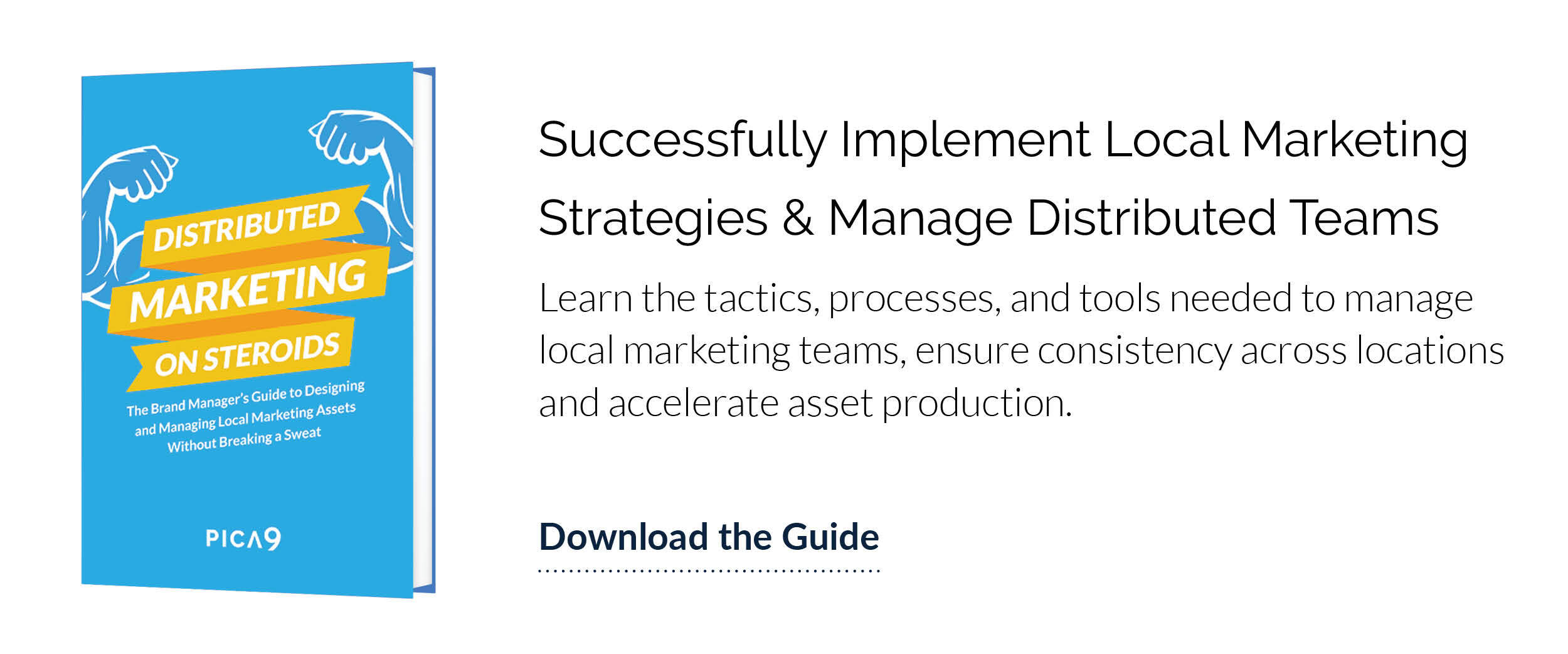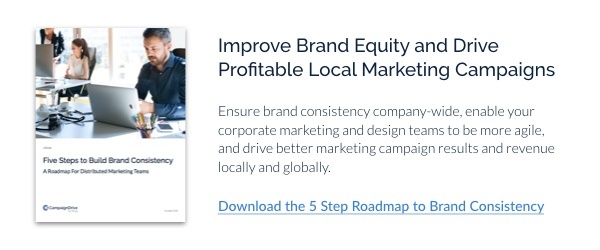What do logos and legal copy have it common? Both elements are the cornerstones of any piece of marketing collateral. If local affiliates misuse either of these elements in their advertising, it won't matter how impressive the rest of the piece looks— it just won't work.
Appropriate use of the brand logo and required legal disclaimers communicates the brand's values which, in turn, builds up the brand's unique customer experience and boosts brand equity as a result.
So what's at stake if local affiliates get logo and legal copy wrong? With 93% of CMOs saying that improving customer experience is a top-three priority, it's no wonder why the world's top distributed brands are taking precautionary steps to guarantee compliant logo and legal usage.
Many industry-leading brands have found creative ways to solve this challenge, both on their own and with innovative solutions like Local Marketing Automation (LMA) software. One thing is for sure: brands have to find the right way to solve these issues for their own location networks or risk getting left behind in the age of customer experience.
How Brands Guarantee Logo and Legal Compliance
As a brand manager, when it comes to logo and legal compliance, there are a few things that you need to have top of mind. More often than not, these concerns primarily involve design layout. Let's say the brand's creative team has created a really nice full-bleed layout for your next advertising campaign.
When it gets down to local marketing, every local affiliate will feel more than happy to slap a low-res version of their logo on the lower left corner, at twice the appropriate size, and call it a day. The creative team will protest and say you can't allow it. If you agree, your local affiliates will be upset and find some way to do exactly what they want anyways.
And what about fitting in legal disclaimers? You know how painful it can be to get a campaign through legal review. Days of waiting on revisions and comments and finally it's done: the creative team has produced another expertly-crafted layout featuring two tastefully executed lines of legal copy that the lawyers picked over to be sure it was just-so.
But once it gets to the local affiliate you know what's bound to happen: that important legal disclaimer will be rendered illegible when the affiliate decides it's time to swap in that photo they've been dying to use. Again, the creative team will object and, even worse, the lawyers will be all over you about the validity of the local offer.
Why Logo and Legal Compliance Matters
Why does all of this matter? For any brand manager, "protecting" the brand is job number one. If local affiliates can mess around with the logo and legal elements that the brand has worked so hard to create, those questionable local-level decisions will reflect poorly on the national brand.
When logos are being misused by local affiliates, brands run the risk of destabilizing the connection they've built up between the customer and brand. When the image and identity of the brand hangs in the balance, why leave brand compliance to chance?
Additionally, legal content can be a major problem for multi-location brands due to the many regulations that they have to comply with. Not only does this mean there are lots of highly-specific rules that need to be followed, but when you've got many different locations your brand could be subject to totally different rules depending on the jurisdiction.
Brands like these often operate across state lines or even international borders, which means they have to put legal protections in place for each unique locale. There are also many restrictions based on the product or service being sold. These and other legal complexities are a huge problem when brand managers are working with their distributed locations.
Learn More: How to Make Brand Compliance Easy for Local Marketers
The Easiest Way To Ensure Compliance
When it comes to legal, the first thing that a creative team should do is pass each piece of marketing collateral through a stringent vetting process to test designs with varying levels of content. You need to have the design or marketing team literally put different amounts of content into the layout to figure out what's workable.
Look for the "breaks" in the layout where adding more/different content causes problems and identify scenarios in where the content looks out of place. You won't find every single one, but if you can figure out the easiest examples with this quick QA process you'll be much better off for it. Once you've analyzed these problem areas, you need to establish clear guidelines to determine how the design should flex in various situations including long, short and multi-language copy.
What about logos? This is a much harder task to resolve without resorting to specialized software like Local Marketing Automation. A good first step distributed brands can take to guarantee logo compliance is to keep a record of all the logos that local affiliates have requested in the past.
There will typically be two types of logos: the ones you own and the ones that your local affiliates want to use to feature themselves or a partner of theirs. Keep record of as many of these files that are useful. Then, use this database to test various logos in your designs. If they like to use your brand's stacked logo over the horizontal one, your design should be able to fit both types comfortably.
When it comes to logos you don't own, things are trickier. Be proactive in looking for high-resolution versions of those logos to mitigate future issues with quality. Reach out to the partner company and ask them if they've got anything that's a vector – or at least tell the local affiliate to get that version for you.
Adding Software: Set Logo and Legal Compliance Rules with LMA
The world's top multi-location brands leverage the power of LMA software to guarantee logo and legal compliance more efficiently. To begin, the savviest brands introduce the following key foundational elements into their LMA solutions:
- Logo Clear Space: Top multi-location brands establish strict logo "clear space" rules in the marketing templates in their LMA systems. These requirements prevent users from placing design elements within a certain distance of a logo lockup based on the brand's standards.
- Anchored Content: Oftentimes legal copy is "anchored" to a particular design element or locale. Typically, legal disclaimers will be found at the bottom of the document, but they could end up rotated along the side of an ad or placed over an image depending on the design. It's important for brands to delineate legal copy from the rest of the advertisement in their LMA systems so they make sure local affiliates clearly understand how it's being used.
With access to a ready-made templating system, brand managers can pre-bake most of these kinds of rules into design of the template, allowing local affiliates to manipulate some parts of the design but not all. Within these templates, brand managers will be able to easily test copy length and shrink or wrap legal copy to achieve the best look. Additionally, in advanced systems marketers have the ability to automatically trigger legal copy to update based on what choices the local affiliates have made in their advertising.
When it comes to logos, LMA solutions allow brand managers to get around a lot of the issues that would normally take a lot of design time to solve. They can pre-define areas on the template where logos can and should be added. While the local affiliate may want to see their logo slapped on the top of the document in big and bold lettering, brand managers can tell local affiliates exactly where the logo should be placed and how large it's allowed to be so they don't end up with a lot of ruined designs in their inbox.
Then there are the dreaded resolution and file format issues. How can LMA ensure that local affiliates are using high-quality artwork even when they don't know the difference between .EPS and .JPEG? While LMA tools can't solve the knowledge problem, they will specify minimum resolution and file format requirements in templates so that some of those unwanted mistakes are stopped before they start. Advanced LMA solutions can even use specialized logo optimization tools which run a set of checks and adjustments to keep the partnership logos that local affiliates supply looking their best.
Ready to Improve Brand Compliance?
When managing hundreds of local affiliates all trying to get their five minutes of advertising fame, adopting a good LMA solution is a sure-fire way to improve the quality of that marketing, especially for logo and legal compliance. With convenient templating, file storage, localization and reporting tools, LMA solutions empower local affiliates to do their best marketing work while staying on-brand at all times.
These systems protect the brand identity of all kinds of leading brands, including Marriott, Polaris, The Melting Pot and more. If you've been seeing a lot of local ads with skewed logos or slippery-sounding legal, a Local Marketing Automation platform could be the key to keep your affiliates in-line and on-brand.
CampaignDrive by Pica9 is a distributed brand management software that ensures compliance and consistency across every location.







